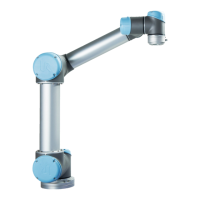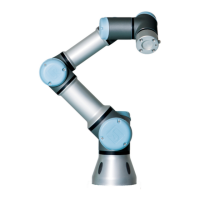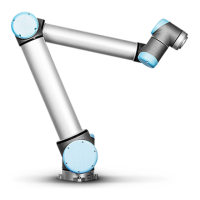WARNING
Make sure the robot arm is properly and securely bolted in place. Unstable
mounting can lead to accidents.
Securing the Robot Arm
Figure Holes for mounting the robot. Use four M6 bolts. All measurements are in
mm.below shows where to drill holes and mount the screws. You can purchase an
accurate base counterpart as an accessory.
1. Mount the robot on a sturdy, vibration-less, surface that can withstand at least ten
times the full torque of the base joint and at least five times the weight of the robot
arm.
2. If the robot is mounted on a linear axis, or a moving platform, then the acceleration
of the moving mounting base is very low. High acceleration might cause the robot
to make a safety stop.
3. Tighten the bolts to 6.5Nm torque.
4. Use the two Ø5 holes provided, with a pin, to accurately reposition robot arm.
WARNING
Power down the robot arm to prevent unexpected start-up during
mounting and dismounting.
To power down the robot arm:
1. Press the power button on the Teach Pendant to turn off the robot.
2. Unplug the mains cable / power cord form the wall socket.
3. Allow 30 seconds for the robot to discharge any stored energy.
CAUTION
Mount the robot in an environment suited to the IP rating. The robot must
not be operated in environments that exceed those corresponding to the
IP ratings of the robot (IP54), Teach Pendant (IP54) and Control Box
(IP44)
Holes for mounting the robot. Use four M6 bolts. All measurements are in mm.
Tool
The robot tool flange has four M6 thread holes for attaching a tool to the robot. The M6
bolts must be tightened with 8N m, strength class 8.8. For accurate tool repositioning,
use a pin in the Ø6 hole provided. Figure The tool output flange (ISO 9409-1-50-4-M6) is
where the tool is mounted at the tip of the robot. All measures are in mm.on the next
Hardware Manual 25 UR5e
3.Mechanical Interface
Copyright © 2009–2022 by UniversalRobotsA/S. All rights reserved.
